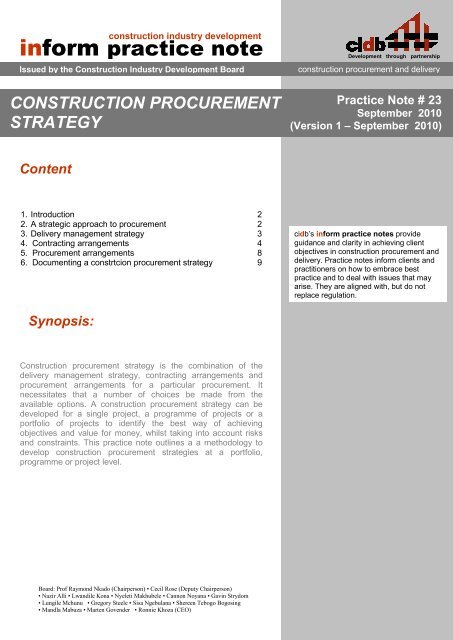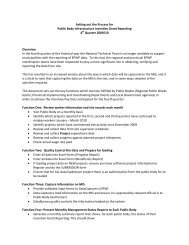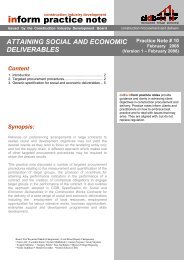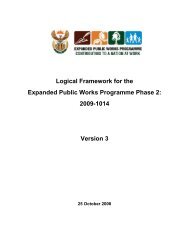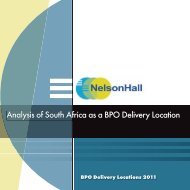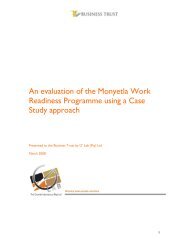Construction Procurement Strategy: Practise Note #23
Construction Procurement Strategy: Practise Note #23
Construction Procurement Strategy: Practise Note #23
Create successful ePaper yourself
Turn your PDF publications into a flip-book with our unique Google optimized e-Paper software.
construction industry development<br />
inform practice note<br />
Issued by the <strong>Construction</strong> Industry Development Board<br />
Development through partnership<br />
construction procurement and delivery<br />
CONSTRUCTION PROCUREMENT<br />
STRATEGY<br />
Practice <strong>Note</strong> # 23<br />
September 2010<br />
(Version 1 – September 2010)<br />
Content<br />
1. Introduction 2<br />
2. A strategic approach to procurement 2<br />
3. Delivery management strategy 3<br />
4. Contracting arrangements 4<br />
5. <strong>Procurement</strong> arrangements 8<br />
6. Documenting a constrtcion procurement strategy 9<br />
cidb’s inform practice notes provide<br />
guidance and clarity in achieving client<br />
objectives in construction procurement and<br />
delivery. Practice notes inform clients and<br />
practitioners on how to embrace best<br />
practice and to deal with issues that may<br />
arise. They are aligned with, but do not<br />
replace regulation.<br />
Synopsis:<br />
<strong>Construction</strong> procurement strategy is the combination of the<br />
delivery management strategy, contracting arrangements and<br />
procurement arrangements for a particular procurement. It<br />
necessitates that a number of choices be made from the<br />
available options. A construction procurement strategy can be<br />
developed for a single project, a programme of projects or a<br />
portfolio of projects to identify the best way of achieving<br />
objectives and value for money, whilst taking into account risks<br />
and constraints. This practice note outlines a a methodology to<br />
develop construction procurement strategies at a portfolio,<br />
programme or project level.<br />
Board: Prof Raymond Nkado (Chairperson) • Cecil Rose (Deputy Chairperson)<br />
• Nazir Alli • Lwandile Kona • Nyeleti Makhubele • Cannon Noyana • Gavin Strydom<br />
• Lungile Mchunu • Gregory Steele • Sisa Ngebulana • Shereen Tebogo Bogosing<br />
• Mandla Mabuza • Marten Govender • Ronnie Khoza (CEO)
1. Introduction<br />
Research indicates that the traditional approach to infrastructure<br />
delivery works best when:<br />
• a department or municipality has sufficient in-house<br />
capabilities and capacity to either undertake the design or to<br />
brief consultants and to oversee the design process, and<br />
• the design and associated documentation is completed<br />
before tenders are invited.<br />
The current reality is that departments are experiencing difficulties<br />
in attracting and retaining suitably qualified staff while multidisciplinary<br />
consulting teams involved in the delivery of<br />
infrastructure rarely have completed designs at the time that the<br />
contractor is appointed. This has resulted in:<br />
• severely stressed departmental and municipal oversight<br />
resources,<br />
• a crisis management culture which cuts corners in the<br />
planning processes,<br />
• the fragmentation of design and construction, with aspects<br />
such as constructability and cost modelling determined by<br />
the design team and cost consultant only,<br />
• tasks being allowed to take their course relatively<br />
uncontrolled, sometimes resulting in extreme and<br />
inappropriate risk avoidance or risk transfer,<br />
• a “pay as you go” culture where significant cost overruns are<br />
the order of the day,<br />
The Association for Project Management’s<br />
Body of Knowledge states that “The<br />
procurement strategy should include<br />
potential sources of supply, terms and types<br />
of contract / procurement (for example,<br />
partnering or alliancing - versus commodity<br />
purchasing), conditions of contract, type of<br />
pricing, and method of supplier selection”<br />
• consultant driven projects with perverse incentives (for<br />
example fee rates as a percentage of the value of the<br />
works), and<br />
• a history of under-expenditure and poor service delivery,<br />
particularly by weaker rural municipalities.<br />
Alternative procurement and contracting strategies are needed to<br />
deliver and maintain much needed infrastructure.<br />
2. A strategic approach to procurement<br />
<strong>Strategy</strong> in the delivery and maintenance of construction works<br />
may be considered to be the skilful planning and managing of the<br />
delivery process. It involves a carefully devised plan of action<br />
which needs to be implemented. It is all about taking appropriate<br />
decisions in relation to available options and prevailing<br />
circumstances in order to achieve optimal outcomes.<br />
<strong>Construction</strong> procurement strategy is the combination of the<br />
delivery management strategy, contracting arrangements and<br />
Practice <strong>Note</strong> # 23 2 of 4
procurement arrangements for a particular procurement. A<br />
construction procurement strategy can be developed for a single<br />
project, a programme of projects or a portfolio of projects to<br />
identify the best way of achieving objectives and value for money,<br />
whilst taking into account risks and constraints. Once the<br />
necessary decisions relating to the delivery management strategy,<br />
the contracting strategy and the procurement arrangements have<br />
been made, the procurement strategy may be implemented in<br />
respect of each package. Thereafter, depending upon the choices<br />
that are made, the design team might need to be managed, and<br />
the contract managed or administered in accordance with the<br />
provisions of the contract. Programme management will also be<br />
required where projects are delivered in terms of a programme.<br />
It is important to conduct an annual evaluation of the efficacy of<br />
decisions made. This will inform the choices made in the<br />
subsequent year and contribute to any improvements in decisions<br />
made in subsequent years.<br />
3. Delivery management strategy<br />
The first stage in developing a procurement strategy is to decide<br />
on the delivery management strategy. The development of a<br />
delivery management strategy can, however, only be embarked<br />
upon for a portfolio or programme of projects after the deliverable<br />
at the end of the infrastructure planning stage has been produced<br />
i.e. a medium term expenditure infrastructure plan which links<br />
prioritised needs to a forecasted budget. (See inform practice note<br />
#22 CIDB Infrastructure Gateway System)<br />
The key activities in the this stage are as follows:<br />
Activity 1: Gather and analyse information<br />
Step Description Output<br />
1 Conduct a spend<br />
analysis<br />
Spatially located work items in the<br />
infrastructure plan grouped into categories<br />
of spend with common attributes.<br />
2 Conduct an<br />
Descriptions of client organisational<br />
organisational analysis<br />
3 Conduct a market<br />
analysis<br />
characteristics<br />
Descriptions of market characteristics<br />
Definitions from ISO 10845-1:<br />
<strong>Construction</strong> procurement – Part 1:<br />
Processes, methods and procedures<br />
procurement strategy: selected packaging,<br />
contracting, pricing and targeting strategy<br />
and procurement procedure for a<br />
particular procurement<br />
contracting strategy: strategy that governs<br />
the nature of the relationship which the<br />
employer wishes to foster with the<br />
contractor, which in turn determines the<br />
risks and responsibilities between the<br />
parties to the contract and the<br />
methodology by which the contractor is to<br />
be paid<br />
pricing strategy: strategy which is adopted<br />
to secure financial offers and to<br />
remunerate contractors in terms of the<br />
contract procurement strategy: selected<br />
packaging, contracting, pricing and<br />
targeting strategy and procurement<br />
procedure for a particular procurement<br />
targeting strategy: strategy which is<br />
adopted to promote secondary<br />
procurement policy objectives<br />
secondary procurement policy:<br />
procurement policy that promotes<br />
objectives additional to those associated<br />
with the immediate objective of the<br />
procurement itself<br />
delivery management is the management<br />
of the process of public service delivery as<br />
applied to infrastructure and maintenance<br />
projects<br />
Activity 2: Formulate procurement objectives<br />
Step Description Output<br />
1 Formulate primary Identified primary procurement objectives<br />
procurement objectives<br />
2 Formulate secondary<br />
procurement objectives<br />
Documented and prioritised secondary<br />
procurement objectives<br />
Activity 3: Make strategic delivery management decisions<br />
Description<br />
Decide on how needs are to be met i.e. through:<br />
Proposition 1: a public private partnership (PPP)<br />
Proposition 2: an implementing agent<br />
Proposition 3: another organ of state’s framework<br />
agreement<br />
Proposition 4: leasing of property<br />
Proposition 5: outsourcing<br />
Proposition 6: own resources<br />
Output<br />
A delivery<br />
management plan<br />
which indicates how<br />
each categories of<br />
spend or portions<br />
thereof are to be<br />
delivered.<br />
Practice note # 23 3 of 10
package: construction works which have been grouped<br />
together for delivery under a single contract or a package<br />
order<br />
The concept of packages<br />
Depending upon the decisions that is taken, it may be<br />
necessary to:<br />
• follow National Treasury PPP procedures;<br />
• enter into service level agreement with an<br />
implementing agent;<br />
• approach an organ of state to make use of their<br />
framework agreement; or<br />
• procure a lease<br />
Activity 4: Decide on delivery mode (project or programme)<br />
Description<br />
Decide on<br />
programme of<br />
projects or series of<br />
independent projects<br />
Output<br />
Categories of spend or portions<br />
thereof delivered as a programme of<br />
projects or a series of independent<br />
projects<br />
Activity 5: Package works<br />
Projects are grouped together or divided into packages<br />
for delivery under a single contract or a package order<br />
issued in terms of a framework agreement.<br />
Step Description Output<br />
1 Identify<br />
opportunities for<br />
framework<br />
agreements<br />
Categories of spend or<br />
portions thereof to be<br />
implemented through own<br />
framework agreements.<br />
2 Identify packages A package plan for<br />
construction and maintenance<br />
projects or a combination<br />
thereof which states the mode<br />
of delivery for and identifies<br />
each package<br />
1<br />
Gather and<br />
analyse<br />
information<br />
2<br />
Formulate<br />
procurement<br />
objectives<br />
3<br />
Make strategic<br />
delivery<br />
management<br />
decisions<br />
Meet need for works<br />
through:<br />
• a PPP<br />
• an Implementing<br />
agent (IA)<br />
• another organ of<br />
state’s framework<br />
agreement (FA)<br />
• leasing of property<br />
• outsourcing<br />
• own resources<br />
4<br />
Decide on<br />
delivery mode<br />
(project or<br />
programme)<br />
Follow PPP procedures if a<br />
PPP<br />
Enter into service level<br />
agreement if IA involved<br />
Approach organ of state to<br />
make use of framework<br />
agreement<br />
Procure a lease<br />
5<br />
Package<br />
works<br />
Developing a delivery management strategy<br />
4. Contracting arrangements<br />
The second stage in developing a procurement strategy is to<br />
decide on the contracting strategy for each package and the<br />
professional services required to implement the contracting<br />
strategy. The organisational and market analyses and primary<br />
and secondary procurement objectives provide the basis for the<br />
making of decisions regarding the choice of contracting options.<br />
Practice <strong>Note</strong> # 23 4 of 10
Activity 1: Allocate risks for packages<br />
Step Description Output<br />
1<br />
2<br />
Decide service requirements<br />
and / or contracting strategy<br />
Decide on pricing strategy<br />
Risk allocations for each<br />
package i.e. allocation of<br />
responsibilities, pricing strategy<br />
3 Decide on form of contract and standard form of contract<br />
The options for service requirements are:<br />
• construction only<br />
• maintenance only<br />
• mainenance and construction<br />
• construction, maintrenance and operation<br />
The responsibilities for design and management of the of<br />
construction works can be allocated between the parties in terms<br />
of any of the following contracting strategies:<br />
Contracting strategy<br />
Design by employer<br />
Develop and construct<br />
Design and construct<br />
<strong>Construction</strong><br />
management<br />
Management<br />
contractor<br />
Description<br />
Contract under which a contractor undertakes only construction on the basis of full designs issued by the<br />
employer<br />
(Design is a separate function to construction)<br />
Contract based on a scheme design prepared by the client under which a contractor produces drawings<br />
and constructs it<br />
Contract in which a contractor designs a project based on a brief provided by the client and constructs it<br />
Contract under which a third party (professional service provider) provides consultation during the design<br />
stage and is responsible for planning and managing all post-contract activities for contractors appointed by<br />
the employer<br />
Contract under which a contractor provides consultation during the design stage and is responsible for<br />
planning and managing all post-contract activities and for the performance of the whole of the contract<br />
The pricing strategies are:<br />
Pricing strategy<br />
Price<br />
based<br />
contracts<br />
Cost<br />
based<br />
contracts<br />
Description<br />
<strong>Construction</strong> works contracts only<br />
Activity schedule<br />
(lump sum)<br />
Bill of quantities<br />
Maintenance contracts only<br />
Priced contract<br />
with price list<br />
Constriction works and maintenance<br />
Cost reimbursable<br />
Target cost<br />
The contractor undertakes to break the scope of work down into activities related to a programme<br />
and price each activity as a lump sum, which he is paid on completion of the activity. The total of<br />
the activity prices is the lump sum price for the contract work.<br />
The bill of quantities lists the items of work and the estimated / measured quantities and rates<br />
associated with each item to allow contractors to be paid, at regular intervals, an amount equal to<br />
the agreed rate for the work multiplied by the quantity of work actually completed<br />
The price list contains the lump sum prices for each required service and quantities and rates for<br />
repeated services to enable contractors to be paid for services provided.<br />
Contract in which the contractor is paid for his actual expenditure plus a percentage or fee<br />
Cost reimbursable contract in which a target cost is estimated and on completion of the works the<br />
difference between the target cost and the actual cost is apportioned between the employer and<br />
contractor on an agreed basis<br />
Practice note # 23 5 of 10
Option<br />
<strong>Construction</strong> only<br />
Maintenance only<br />
Maintenance and<br />
construction<br />
<strong>Construction</strong><br />
maintenance and<br />
operation<br />
The options for forms of contract are stipulated in the CIDB<br />
Standard for Uniformity in Constrtcion <strong>Procurement</strong>, as follows:<br />
:<br />
Form of contract<br />
• NEC3 Engineering and <strong>Construction</strong> Contract<br />
• NEC3 Engineering and <strong>Construction</strong> Short Contract.<br />
• FIDIC Conditions of Contract for <strong>Construction</strong> and Building and Engineering Works Designed by the<br />
Employer<br />
• FIDIC Conditions of Contract for Plant and Design<br />
• FIDIC Conditions of contract for EPC Turnkey Projects<br />
• FIDIC Short Form of Contract General Conditions (Short Form)<br />
• JBCC Principal Building Agreement<br />
• JBCC Minor Works Agreement<br />
• GCC 2010<br />
• CIDB General conditions of contract<br />
• NEC3 Term Service Contract<br />
• NEC3 Short Term Service Contract<br />
NEC3 Engineering and <strong>Construction</strong> Contract with or without NEC3 Term Service Contracts<br />
• FIDIC Conditions of Contract for Design, Build and Operate Projects<br />
• NEC3 Engineering and <strong>Construction</strong> Contract plus NEC3 Term Service Contracts<br />
Does the works satisfy all of the<br />
following statements:<br />
a) the works:<br />
i) are straightforward or<br />
repetitive in nature<br />
ii) are of short duration;<br />
iii) have almost no requirement<br />
for sophisticated<br />
management techniques;<br />
and<br />
iv) impose only low risks on both<br />
employer and the contractor;<br />
and<br />
b) the design of the works is almost<br />
complete when construction<br />
starts?<br />
What are the contractual<br />
arrangements?<br />
design by employer<br />
No<br />
design and build / develop and<br />
construct<br />
management contract<br />
Yes<br />
Buildings and infrastructure<br />
FIDIC Short Form (Green Book)<br />
NEC3 Engineering and <strong>Construction</strong> Short<br />
Contract<br />
Buildings only<br />
JBCC Minor Works Agreement<br />
Buildings and infrastructure<br />
FIDIC Red Book<br />
GCC 2010<br />
NEC3 Engineering and <strong>Construction</strong><br />
Contract<br />
Buildings only<br />
JBCC Principal Building Agreement<br />
Buildings and infrastructure<br />
FIDIC Yellow Book or FIDIC Silver Book<br />
GCC 2010<br />
NEC3 Engineering and <strong>Construction</strong><br />
Contract<br />
Buildings and infrastructure<br />
FIDIC Silver Book<br />
NEC3 Engineering and <strong>Construction</strong><br />
Contract<br />
Identifying a suitable form of contract for construction works<br />
Activity 2: Establish requirements for outsourced professional services<br />
Description<br />
Identify services areas that are<br />
required<br />
Output<br />
Identified professional services which<br />
need to be procured<br />
Practice <strong>Note</strong> # 23 6 of 10
Activity 3: Package professional service contracts<br />
Step Description Output<br />
1 Decide on<br />
contracting<br />
strategy<br />
2 Decide on the<br />
type of contract<br />
Requirements for outsourced professional<br />
services categorized as single discipline or<br />
multidisciplinary<br />
Requirements for outsourced professional<br />
services linked to a specific package or a<br />
programme or a number of undefined packages<br />
or programmes<br />
The contracting strategy can be discipline specific or for a<br />
multidisciplinary service. The type of contract can be package<br />
specific, programme related or linked to a framework agreement.<br />
Activity 4: Allocate risks for professional service contracts<br />
Step Description Output<br />
1 Decide on pricing<br />
strategy<br />
Identified pricing strategy for required<br />
professional services<br />
2 Decide on form of<br />
contract<br />
Identified standard form of contract for a<br />
professional service contract<br />
The options for pricing strategy options are priced contract, fee<br />
percentage based on cost of construction, cost reimbursable<br />
contract or target cost contract. Use can only be made of the NEC<br />
Professional Service Contract or the CIDB Standard Professional<br />
Service Contract.<br />
Pricing strategy<br />
Price based<br />
Cost of construction<br />
Cost of Cost reimbursable<br />
construction<br />
Target cost<br />
Description<br />
The consultant undertakes to break the scope of work down into activities and price each activity<br />
as a lump sum, which he is paid on completion of the activity The total of the activity prices is<br />
the lump sum price for the contract work<br />
The consultant’s fee is based on a percentage of the cost of the construction works<br />
Contract in which the consultant is paid for his time expended at agreed rates<br />
Cost reimbursable contract in which a target cost is estimated and on completion of the service<br />
the difference between the target cost and the actual cost is apportioned between the employer<br />
and contractor on an agreed basis<br />
1<br />
Allocate risks<br />
for packages<br />
Options for services:<br />
• construction<br />
• construction and maintenance<br />
• maintenance<br />
• construction, maintenance and<br />
operation<br />
2<br />
Establish<br />
requirements for<br />
outsourced<br />
professional<br />
services<br />
3<br />
Package<br />
professional<br />
service<br />
contracts<br />
4<br />
Allocate risks<br />
for professional<br />
service<br />
contracts<br />
Contracting strategy<br />
• Design by employer<br />
• Develop and construct<br />
• Design and construct<br />
• <strong>Construction</strong> management<br />
• Management contractor<br />
Pricing strategy:<br />
• Priced contract with a<br />
priced list<br />
• Cost reimbursable<br />
• Target cost<br />
• Activity based<br />
• Lump sum<br />
• Bill of quantities<br />
CIDB<br />
accepted<br />
Form of<br />
Contract<br />
• Discipline specific or<br />
multidisciplinary service<br />
• Package specific, programme<br />
related or framework<br />
agreement<br />
• Priced contract, percentage of<br />
cost of construction, cost<br />
reimbursable or target cost<br />
Deciding on contractual arrangements<br />
Practice note # 23 7 of 10
5. <strong>Procurement</strong> arrangements<br />
The final stage in developing a procurement strategy is to decide<br />
on the procurement arrangements.<br />
Activity 1: Decide on quality strategy<br />
Description<br />
Determine quality strategy<br />
Output<br />
Suitable quality strategies<br />
Quality may be achieved through:<br />
• Specifications<br />
• Life cycle costing<br />
• Prequalification<br />
• Evaluation criteria<br />
• Undertakings at tender stage<br />
• Preferences<br />
• Eligibility criteria<br />
Activity 2: Decide on procurement procedure<br />
Description<br />
Determine procurement<br />
procedure<br />
Output<br />
A suitable procurement procedure<br />
The procurement procedures options involve the use of one of the<br />
following procedures with or without eligibility criteria:<br />
See CIDB Standard for Uniformity in<br />
<strong>Construction</strong> <strong>Procurement</strong> and ISO<br />
10845-1, <strong>Construction</strong> <strong>Procurement</strong> Part<br />
1- Processes, methods and procedures<br />
• Competitive selection procedure<br />
o Nominated<br />
o Open<br />
o Qualified<br />
o Quotation<br />
o Proposal procedure using the two-envelope system<br />
o Proposal procedure using the two-stage tendering system<br />
• Negotiation procedure<br />
• Competitive negotiations procedure<br />
o<br />
o<br />
Open<br />
Restricted<br />
Activity 3: Decide on targeted procurement strategy<br />
Description<br />
Determine targeted<br />
procurement strategy<br />
Output<br />
Suitable targeted procurement procedures<br />
The targeted procurement procedure options are:<br />
• Preferencing<br />
• Incentives for attaining Key Performance Indicators (KPI’s)<br />
• Mandatory subcontracting<br />
• Contractual obligations<br />
Practice <strong>Note</strong> # 23 8 of 10
Activity 4: Decide on a tender evaluation procedure<br />
Description<br />
Identify the appropriate<br />
tender evaluation procedure<br />
Output<br />
A suitable tender evaluation<br />
procedure<br />
Tender evaluation procedure options are:<br />
• Method 1:Finacial offer<br />
• Method 2: Financial offer and preferences<br />
• Method 3: Financial offer and quality<br />
• Method 4: Financial offer, quality and preferences<br />
1<br />
Decide on<br />
quality strategy<br />
2<br />
Decide on procurement<br />
procedure<br />
3<br />
Decide on targeted<br />
procurement strategy<br />
4<br />
Decide on tender<br />
evaluation procedure<br />
Deciding on the procurement arrangements<br />
6. Documenting a construction<br />
procurement strategy<br />
The constrtcion procurement strategy arrived at by applying the<br />
aforementioned procedures needs to be documented in such a<br />
manner that the logic behind the choices that are made at each<br />
step can be communicated to and reviewed by others.<br />
Accordingly, the specific inputs and outputs of the actions at each<br />
step in the stages of the development of a strategy needs to be<br />
documented.<br />
A construction procurement strategy at a portfolio level should be<br />
documented in a tabular form which links each category or portion<br />
of a category of spend to a number of high level descriptions.<br />
<strong>Procurement</strong> strategies at a programme level can be similarly<br />
presented, with perhaps, more detailed descriptors. The strategic<br />
brief that is developed for a package during the package<br />
information stage of the package planning phase must, however,<br />
set out all the choices made in relation to the package in sufficient<br />
detail to enable procurement documents to be drafted to enable<br />
the necessary procurement processes to commence.<br />
Practice note # 23 9 of 10
inform<br />
construction industry development<br />
practice note<br />
Practice note 23 – September 2010<br />
We would like to hear from you about<br />
your progress, challenges and ideas.<br />
Contact us:<br />
E-mail: infocus@cidb.org.za<br />
Fax: 012 343 7153<br />
See IDMS Practice Guide for <strong>Construction</strong> <strong>Procurement</strong><br />
<strong>Strategy</strong> for comprehensive guidance on the making of<br />
appropriate choices and decisions<br />
CIDB Switchboard 086 100 2432<br />
Registers Helpdesk 086 010 3353<br />
Registers Post Private Bag x14<br />
Brooklyn Square<br />
0075<br />
CIDB Post: PO Box 2107<br />
Brooklyn Square<br />
0075<br />
<strong>Procurement</strong> strategy for works<br />
Category<br />
of spend<br />
Delivery management<br />
strategy<br />
Contracting arrangements<br />
strategy for work<br />
<strong>Procurement</strong> arrangements for works<br />
Meet needs through<br />
proposition no<br />
Programme / project<br />
Packaging no / type<br />
Contracting strategy<br />
Pricing strategy<br />
Form of contract<br />
Quality strategy<br />
<strong>Procurement</strong><br />
arrangements<br />
Targeted procurement<br />
strategy<br />
Evaluation procedure<br />
A<br />
B<br />
<strong>Procurement</strong> strategy for professional services<br />
Category<br />
of spend<br />
Delivery management strategy<br />
Contracting arrangements<br />
for professional services<br />
<strong>Procurement</strong> arrangements for<br />
professional services<br />
Meet needs<br />
through<br />
Programme /<br />
project<br />
Packaging<br />
arrangements<br />
Service area<br />
Contract strategy<br />
Type of contract<br />
Pricing strategy<br />
Form of contract<br />
Quality strategy<br />
<strong>Procurement</strong><br />
arrangements<br />
Targeted<br />
procurement<br />
strategy<br />
Evaluation<br />
procedure<br />
A<br />
B<br />
Development through partnership<br />
cidb website: www.cidb.org.za<br />
Practice <strong>Note</strong> # 23 10 of 10


